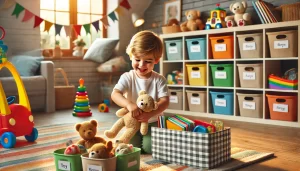Emotions play a crucial role in a child’s development, affecting their behavior, relationships, and ability to handle challenges. While children naturally experience a wide range of emotions, they don’t always know how to express them in a healthy way. Teaching kids how to understand, regulate, and express their feelings helps them build emotional intelligence and resilience.
In this article, we’ll explore why emotional regulation is important, common challenges children face with emotions, and practical strategies to help them develop healthy coping mechanisms.
Why Is It Important to Teach Children Emotional Regulation?
Children who learn to manage their emotions effectively:
- Have better self-control and can handle frustration more easily.
- Develop stronger social skills, leading to healthier relationships.
- Experience less anxiety and stress when dealing with challenges.
- Are more resilient, bouncing back from setbacks with confidence.
When children struggle with emotional regulation, they may have frequent tantrums, difficulty following rules, or trouble interacting with others. Teaching emotional skills early sets a foundation for long-term mental well-being.
Understanding Common Emotional Challenges in Children
Before helping children manage their emotions, it’s important to understand the difficulties they face.
Lack of Emotional Vocabulary
Young children may struggle to express their emotions simply because they don’t have the words to describe how they feel.
Difficulty Controlling Impulses
Children often react impulsively to strong emotions, such as hitting when they’re angry or crying when they’re frustrated.
Overwhelm from Strong Emotions
Sometimes, emotions can feel too big for children to handle, leading to meltdowns, withdrawal, or outbursts.
Struggles with Social Interactions
Children may feel hurt when friends don’t share, frustrated when they lose a game, or anxious in new situations.
By recognizing these challenges, parents and caregivers can provide the right support to help children navigate their emotions effectively.
Strategies to Help Children Manage Their Emotions
Help Children Identify and Name Their Emotions
Encourage children to recognize and name their feelings by saying things like:
- “I see that you’re feeling frustrated because your block tower fell.”
- “You look really happy after playing outside!”
Using an emotion chart with facial expressions and labels can help younger children learn the words for different emotions.
Teach That All Emotions Are Normal
Children should know that it’s okay to feel emotions like sadness, anger, or frustration—but how they express them matters. Explain that emotions come and go, and they can learn to handle them in healthy ways.
Model Healthy Emotional Responses
Children learn by watching adults. Show them how to handle emotions calmly and positively:
- Instead of saying, “I’m so angry!” say, “I feel frustrated, so I’m going to take deep breaths to calm down.”
- Talk through your feelings out loud: “I felt sad when my friend canceled our plans, but I decided to do something fun instead.”
Teach Deep Breathing and Calming Techniques
Simple breathing exercises help children calm down when they feel overwhelmed. Try:
- “Smell the Flower, Blow Out the Candle” – Inhale deeply through the nose (smelling the flower), then exhale slowly through the mouth (blowing out the candle).
- Belly Breathing – Place a hand on the belly and take slow breaths, feeling the belly rise and fall.
- Counting to Ten – Helps children pause before reacting impulsively.
Practicing these techniques regularly helps children use them naturally when needed.
Use Stories and Books About Emotions
Books can be a great way to help children understand and talk about feelings. Some great options include:
- The Color Monster by Anna Llenas (teaches about different emotions).
- When Sophie Gets Angry—Really, Really Angry by Molly Bang (helps children learn how to manage anger).
- In My Heart: A Book of Feelings by Jo Witek (explores a wide range of emotions).
After reading, ask questions like:
- “How do you think the character felt?”
- “What would you do in that situation?”
Encourage Physical Activity to Release Emotions
Movement helps children process and regulate emotions. Activities like:
- Running, jumping, or dancing to release built-up energy.
- Squeezing a stress ball or playing with playdough to relieve tension.
- Practicing yoga or stretching exercises for relaxation.
These physical outlets help children manage strong emotions in a healthy way.
Create a Calm-Down Space
A designated “calm-down corner” at home gives children a safe space to regulate their emotions. Include:
- Soft pillows or a cozy chair.
- Books about feelings.
- Fidget toys or stress-relief objects.
Encourage children to use this space when they feel overwhelmed, rather than reacting impulsively.
Teach Problem-Solving Skills
Help children learn to solve problems calmly by asking guiding questions:
- “What made you upset?”
- “What could you do differently next time?”
- “How can we fix this problem together?”
This empowers children to handle challenges with confidence.
Encourage Expressing Emotions Through Art
Drawing, painting, or journaling can be great ways for children to express how they feel.
- Ask them to draw their feelings – “What does your anger/sadness/happiness look like?”
- Encourage storytelling – “Write a story about a time you felt really excited!”
Art provides a creative and safe outlet for emotions.
Use Positive Reinforcement
Praise children when they manage emotions well:
- “You did a great job taking deep breaths instead of yelling when you were upset.”
- “I love how you used your words to tell me what was wrong.”
Encouragement reinforces emotional regulation skills.
How to Support Children Through Difficult Emotions
When They Are Angry
- Validate: “I see you’re angry. It’s okay to feel that way.”
- Offer a solution: “Let’s take deep breaths together.”
- Give choices: “Do you want to go for a walk or listen to music to calm down?”
When They Are Sad
- Comfort them: “I’m here for you. Do you want a hug?”
- Encourage expression: “Would you like to talk about what’s making you sad?”
- Help them find a positive focus: “Let’s do something you enjoy to feel better.”
When They Are Frustrated
- Break tasks into smaller steps.
- Encourage persistence: “Keep trying, you’re getting better!”
- Teach them to ask for help when needed.
When to Seek Professional Help
While emotional ups and downs are normal, consider seeking professional support if your child:
- Has frequent, intense emotional outbursts that disrupt daily life.
- Struggles to calm down even with guidance.
- Shows extreme anxiety, fear, or sadness.
A child psychologist or counselor can provide personalized strategies to support emotional development.
Final Thoughts
Helping children manage their emotions is one of the most valuable life skills parents can teach. By providing tools like emotional vocabulary, calming techniques, and problem-solving strategies, you empower children to handle their feelings in a healthy way.
Through patience, guidance, and daily practice, children can develop strong emotional regulation skills, leading to greater confidence, better relationships, and lifelong well-being.




